Old Sidewalk-Blocking Bike Racks Finally Removed
When Culinaria opened it was a relief having a decent-sized grocery store downtown. A problem was trying to get to the entrance at 9th & Olive. The public sidewalk along 9th was so full it was basically single file for many years.
I got the number of tables reduced — and pushed back out of the way. But the four original “dish drainer” style bike racks remained.
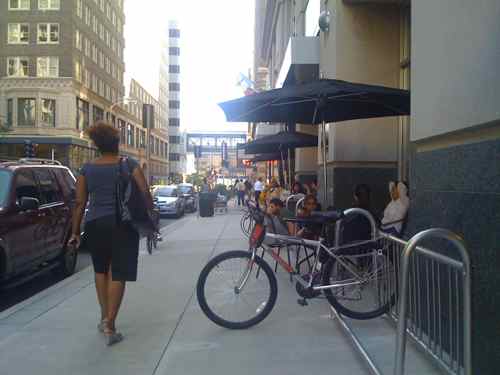
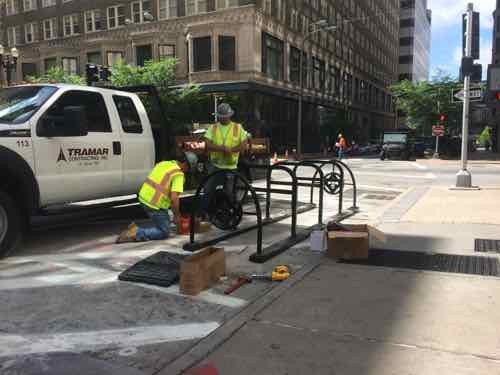
Nearly a year later those old racks that place bikes so they narrow the sidewalk remained in place, getting used at times. On May 10th of this year I asked the manager, Adam, when the old racks would be removed. He wasn’t sure how to get them removed — they were anchored pretty well. So that day I emailed photos to people at Streets Dept and Great Rivers Greenway (did the new rack) to inquire, copying Adam so he’d be in the loop.
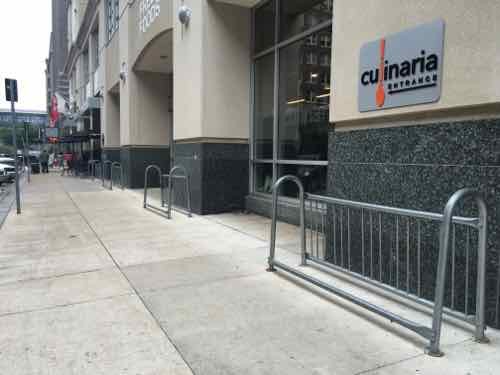
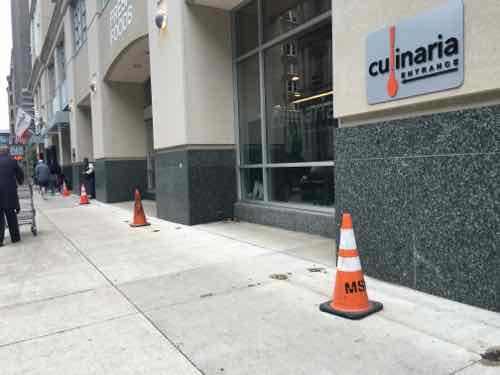
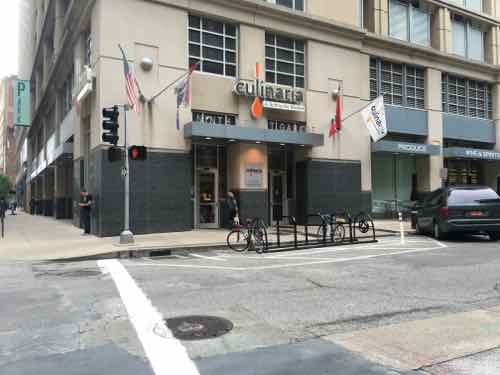
It’s all about how we share the public right-of-way (PROW).
— Steve Patterson
Next, let’s get rid of those “sidewalk blocking” chairs and tables . . . because pedestrians STILL do NOT have full use of the the sidewalk, here and elsewhere!
I’ve gotten the number of tables here reduced significantly. I’ve talked to them about keeping them pushed back toward the building, in the recessed areas. Again this morning I pushed the three tables back.
Worth noting, actually, that the chair/table set-up would be illegal in some other major cities. In Chicago, for instance, all sidewalk cafes must maintain a (almost) continuous border in the form of iron/wood fencing or flower boxes. This creates a uniformity of design and use that respects public way rights.
The other positive offshoot of Chicago’s requirement’s is that the cafe boundary creates a straight-line touch point for cane detection by the blind. The consistency allows confidence in movement.
Not saying that St. Louis needs to go toward a stricter code such as that of Chicago (though I’d support it!). Sidenote: Chicago’s right-of-way requirement is six feet minimum of unencumbered clearance. I think St. Louis’s is…4 feet, maybe?
Yes, huge difference between here and Chicago. Many more people on sidewalks there but it’s actually easier to navigate — except for Michigan Ave at rush periods.
Among those who oppose sidewalk “blocking,” I wonder what minimum free sidewalk width would be acceptable for both able-bodied and disabled pedestrians? 4′, which is a fairly minimum utilitarian sidewalk width in most areas? 4′ is certainly “do-able”, but negotiating it at times may require a bit of give and take. 5′ + as recommended by Great Streets, depending on the venue? Is any level of sidewalk “sharing” acceptable? I remember the restaurant-bar at Washington and 19th, where the restaurant operator hogged all the sidewalk space, forcing pedestrians to negotiate around the tables. Sometimes that was a challenge even for the able-bodied. Steve’s photos show a longitudinal expansion joint. If the area between the expansion joint and the curb were kept “free,” would that the considered acceptable? All over Europe, pedestrians and restaurant operators “share” the sidewalk, and I’ve never heard a complaint or even a suggestion of a complaint. I wonder, in areas where both street and sidewalk widths are fixed, if both the restaurant operator and pedestrians shouldn’t be both more attentive and forgiving?
This sidewalk is one of the busiest downtown. You’ve got people going to/from their cars parked on the street and people coming/going beyond. Many walk 2-3 abreast in both directions.
………….”Many walk 2-3 abreast in both directions”……..but is the ability to do that a god-given right? Would the pedestrians’ quality of life be seriously compromised if they had to walk in a different pattern? It seems to me that in many/most cities (like STL) making these slight concessions and adjustments is part of the “city experience,” in that many/most older cities were developed at a time in history when there was less awareness of and sensitivity to pedestrian/vehicle interaction. So today, part of that “city experience,” at a time when the city is trying to create an environment where pedestrians and cafe operators and their sidewalk-dining patrons can all share in that “city experience” , getting by with what they’ve got, there has got to be some compromise. I’d be happier with a 3-car garage, but I don’t have one, and I get by with what I have. Is it reasonable to ban sidewalk tables and chairs and still expect that these cafe owners will survive? I’ve no real experience in restaurant work, but I seriously doubt that is the case. For whatever reason, people enjoy eating outside on the sidewalk breathing in all the emissions exhaust and avoiding eye contact with deposit of dog crap left behind by a downtown resident’s pet. Imagine such a ban or restriction in Paris or in Kyoto or in Santa Monica or Venice. In many areas of those cities, pedestrians walk around the tables and chairs…and no one seems to be bothered by it!
To clarify, it’s hard to show sarcasm on the interwebs. My point was one of a potential double standard – bikes bad, tables good – not any serious agenda to rid sidewalks of diners. And, as you so eloquently point out, urban living is messy and it takes many, small, ongoing compromises. But as a bike rider, I’d have serious reservations about parking my bike at the new rack, pictured. I’d rather take my chances chained to an inanimate object ON the sidewalk than I would parking in the street, especially next to busy corner!
An example mentioned above, the standard in Chicago is six feet. Looking at the application materials in front of me now, actually, “…fences or barricades must be positioned so that at least six (6) feet separates the outer edge of the barrier from City property such as street signs, planters, newspaper dispensers, fire hydrants, bus shelters or other obstacles or where no obstacles are present, the edge of the sidewalk (not including the curb)…”
This is (or at least, is supposed to be) the standard across the entire city. So it behooves chambers, n’hood groups and taxing districts (and the City itself) to widen their sidewalks –or pay for/install parklets — along commercial districts to encourage the establishment of restaurants — restaurants that might not go there if the sidewalks couldn’t support cafe dining via the City’s requirements.